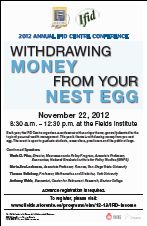 |
THE
FIELDS INSTITUTE FOR RESEARCH IN MATHEMATICAL SCIENCES
20th
ANNIVERSARY
YEAR |
|
November
22, 2012

2012
Annual IFID Centre Conference
Theme:
Withdrawing Money from your Nest Egg
8:30 a.m.-12:30 p.m.
Fields
Institute,222
College St., Toronto
|
 |
|
|
|
|
|
Confirmed Speakers:
Wade D. Pfau, Ph.D., CFA
Director, Macroeconomic Policy Program, Associate Professor, Economics
National Graduate Institute for Policy Studies (GRIPS)
An efficient frontier for retirement income
This article outlines an approach for building a retirement income
strategy, which moves dramatically away from the financial planner
concepts of safe withdrawal rates and failure rates. The focus
is how to best meet two competing financial objectives for retirement:
satisfying spending goals and preserving financial assets. The
process described here focuses on Moshe Milevsky's production
allocation of assets between a portfolio of stocks and bonds,
inflation-adjusted and fixed single-premium immediate annuities
(SPIAs), and immediate variable annuities with guaranteed living
benefit riders (VA/GLWBs). This process incorporates unique client
circumstances, bases asset return assumptions on current market
conditions, uses a consistent fee structure for a fair comparison
between income tools, operationalizes the concept of diminishing
returns from spending by incorporating a minimum needs threshold
and a lifestyle spending goal, uses survival probabilities to
calculate outcomes, and incorporates retiree preferences to balance
the competing financial objectives for the final choice among
the collection of allocations that define the efficient frontier
for retirement income.
Marie-Eve Lachance, Ph.D.
Associate Professor, Finance, San Diego State University
Roth versus traditional accounts in a life-cycle model with tax
risk
When saving for retirement, individuals can choose between front-loaded
accounts with tax-deductible contributions and back-loaded accounts
without them. Canadian front-loaded RRSPs and back-loaded TFSAs
correspond to U.S. traditional and Roth accounts. This presentation
compares front- and back-loaded retirement accounts by introducing
them in a standard life-cycle model. It discusses how to address
the technical challenges encountered when modeling the realistic
tax treatment associated with these accounts. It highlights that
withdrawals from front-loaded accounts can trigger additional taxes
(repayment of OAS benefits in Canada, taxation of Social Security
benefits in the U.S.), which weakens their relative appeal. Last,
tax risk is added to the model to evaluate the risk reduction benefits
of tax diversification strategies that combine the two types of
accounts.
Thomas Salisbury, Ph.D.
Professor, Mathematics and Statistics, York University
Optimizing variable annuity income
Recently, many variable annuity providers have restricted new sales
of products with guaranteed lifetime withdrawals. Despite this,
a very large pool of existing contract holders face decisions about
how much income to draw from their existing products, and when to
draw it. I will discuss this question from a control theory / American
options point of view. (Joint work with Huaxiong Huang and Moshe
A. Milevsky.)
Anthony Webb, Ph.D.
Economist, Center for Retirement Research, Boston College
Should households base asset decumulation strategies on required
minimum distribution tables?
Households managing wealth decumulation in retirement must trade
off the risk of outliving their wealth against the cost of unnecessarily
restricting their consumption. Devising an optimal decumulation
plan, reflecting uncertain mortality and asset returns, is well
beyond the abilities of most households, who likely rely on rules
of thumb. Using numerical optimization, we compare one such rule
of thumb - consuming the age-related percentage of remaining wealth
specified in the IRS Required Minimum Distribution (RMD) tables
– with alternatives and with the theoretical optimal. We
show that in models that incorporate uncertain investment returns
a decumulation strategy based on the RMD tables performs better
than plausible alternatives, such as spending the interest and
dividends, consuming a fixed 4 percent of initial wealth, or decumulating
over the household’s life expectancy. The RMD tables generally
result in too little wealth being consumed at younger ages, and
are, therefore, relatively attractive to households with low intertemporal
elasticities of consumption. But all the above strategies fall
well short of the theoretical optimum.
Program
8:00 am
Registration, Breakfast/Coffee
8:25 am
Welcome, Edward Bierstone, Director, Fields Institute
8:30- 9:20 am
Wade Pfau
Director, Macroeconomic Policy Program; Associate Professor, Economics,
National Graduate Institute for Policy Studies (GRIPS)
An efficient frontier for retirement income
9:20-10:05 am
Anthony Webb
Economist, Center for Retirement Research, Boston College
Should households base asset decumulation strategies on required
minimum distribution tables?
10:10-10:30 am
break
10:30-11:15 am
Marie-Eve Lachance
Associate Professor, Finance, San Diego State University
Roth versus traditional accounts in a life-cycle model with tax
risk
11:20-12:05 pm
Thomas Salisbury
Professor, Mathematics and Statistics, York University
Optimizing variable annuity income
12:15pm
Networking Lunch
back to top
|
 |